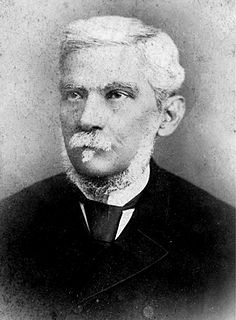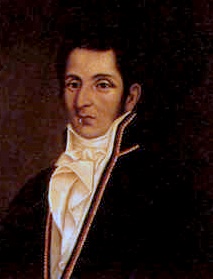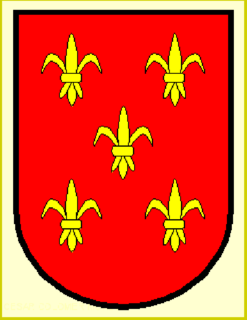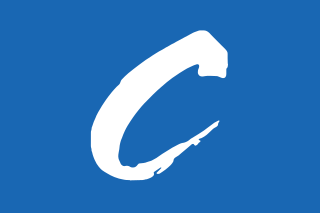
Antonio José de Sucre y Alcalá, known as the "Gran Mariscal de Ayacucho", was a Venezuelan independence leader who served as the fourth President of Peru and the second President of Bolivia. Sucre was one of Simón Bolívar's closest friends, generals and statesmen. The city of Sucre, Bolivia's capital, is named for him, as is a state of Venezuela and a department of Colombia. Both the old and new airports of Ecuador's capital Quito are also named after him.

The Congress of Angostura was convened by Simón Bolívar and took place in Angostura during the wars of Independence of Colombia and Venezuela, culminating in the proclamation of Gran Colombia. It met from February 15, 1819, to July 31, 1821, when the Congress of Cúcuta began its sessions. It consisted of twenty-six delegates representing Venezuela and New Granada.

The Banco de la República is the central bank of the Republic of Colombia. Its main functions are detailed by the Congress according to the Ley 31 de 1992. One of them is the issuance of the Colombian currency, the peso. The bank is also active in promoting financial inclusion policy and is a leading member of the Alliance for Financial Inclusion.

Bartolomé Calvo Díaz de Lamadrid was a Colombian lawyer, journalist, and statesman, who became President of the Granadine Confederation, in what is now Colombia, in 1861 in his role as Inspector General, because no elections were held on that year to decide the presidency. He also served as Governor of Panama and Ambassador to Ecuador, and worked in a number of newspapers.

Manuel María Mallarino Ibargüen was the 8th Vice President of New Granada, and as such served as Acting President from 1855 to 1857.

José María Ramón Obando del Campo was a Neogranadine General and politician who twice served as President of Colombia. As a General, he initially fought for the Royalist Army during the Independence Wars of Colombia, ultimately joining the revolutionary forces of Simón Bolívar towards the end, but once independence was attained he opposed Bolívar's Centralist government.

Manuel Rodríguez Torices was a Neogranadine statesman, lawyer, journalist, and Precursor of the Independence of Colombia. He was part of the Triumvirate of the United Provinces of New Granada in 1815, and served as Vice President of the United Provinces after the triumvirate. He was executed during the Reign of Terror of Pablo Morillo in 1816.

Clímaco Calderón Reyes was a Colombian lawyer and politician, who became 15th President of Colombia for one day, following the death of President Francisco Javier Zaldúa.

José María Campo Serrano was a Colombian lawyer, general, and statesman, who became President of Colombia after the resignation of the President and the dismissal of the Vice President. He sanctioned the Constitution of 1886 that created the Republic of Colombia proceeding the United States of Colombia. A Samarian Costeño, he became president of the Sovereign State of Magdalena, and Antioquia, Governor of Panama, and held various Ministries during his career as a politician.

Jorge Tadeo Lozano, Viscount of Pastrana was a Neogranadine scientist, journalist, and politician who presided over the Constituent College of Cundinamarca and was elected President of Cundinamarca in 1811.

Manuel María Uribe Angel was a Colombian physician, geographer and politician, he has been called the "father of medicine of Antioquia" for his contributions to the advances of the practice of medicine in Colombia and the Antioquia Department. He was also known outside the realm of medicine for his studies and works on the geography and history of Colombia. He also served as President of the then Sovereign State of Antioquia and as Senator of Colombia.

José María Rojas Garrido was a Colombian Senator, and statesmen, who as the first Presidential Designate became Acting President of the United States of Colombia in 1866 during the absence of President elect Tomás Cipriano de Mosquera. He was a prominent journalist for several Liberal Party newspapers, and is considered one of the most important orators in Colombia's history.

Pacífico Chiriboga y Borja (1810–1886) was an active politician during the first years of the Republic of Ecuador. He served as senator, minister, vice-president and acting president during these formative years.
Javier Ocampo López is a Colombian historian, writer, folklorist and professor. He has been important in the fields of Colombian folklore and history of Latin America and Colombia, especially contributing on the department of Boyacá, the homeland of the Muisca and their religion and mythology. He wrote exclusively in Spanish.

Baltasar Maldonado, also written as Baltazar Maldonado, was a Spanish conquistador who first served under Sebastian de Belalcázar in the conquest of Quito and Peru, the foundations of Cali and Popayán, and later in the army of Hernán Pérez de Quesada in the Spanish conquest of the Muisca.

María Ana Carcelén de Guevara y Larrea-Zurbano, 5th Marquise of Villarocha and 7th Marquise of Solanda was an Ecuadorian aristocrat and the wife of the Venezuelan independence leader Antonio José de Sucre. She is considered the 1st First Lady of Bolivia.













































